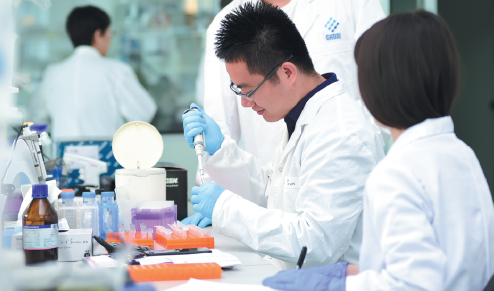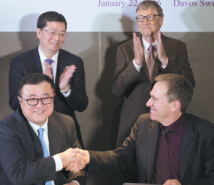Institute at forefront of infectious diseases fight
 |
|
Scientists at the Global Health Drug Discovery Institute in Beijing conduct experiments. The institute has attracted dozens of talented professionals from across the world in fields such as pharmacology and biochemistry. Provided To China Daily |
Links formed with leading global institutions and companies
When explorer Li Huacan took a photograph of Sanji, a 15-year-old Tibetan girl, in 2015, the teenager's yellowing eyes and skin showed that she had a severe illness.
Li was in Qinghai province, kayaking down the Yellow River on a journey of more than 5,400 kilometers to its estuary in Dongying, Shandong province, which he reached in 234 days
Hailing from Qinghai, Sanji had the parasitic disease echinococcosis, which had blocked her gall bladder, causing bile to enter her blood. All she could do was tell her doctor the high degree of pain she was experiencing.
Li said the girl might only have had a slim chance of surviving.
The disease is little-known to most Chinese, but according to the World Health Organization, the country is estimated to have the highest number of such cases worldwide.
In nine western and northern provinces and autonomous regions, an estimated 50 million people are at risk from the disease, and about 170,000 of them are infected, according to a report published in 2017 in the Chinese animal health journal Zhongguo Dongwu Baojian on the epidemiology and spread of echinococcosis in China.
Widely prevalent in rural areas, the disease is caused by some types of tapeworm and is usually transmitted to humans from animals, especially dogs.
People can become infected if they have direct contact with animal hosts, or even by ingesting parasites' eggs in polluted food, water or soil.
Once the tapeworm enters the body, almost all the organs and tissues, such as the liver, lungs, brain and bones, will become damaged.
Echinococcosis is often expensive and complicated to treat. The drugs available on the market have multiple side effects and unreliable efficacy, while surgery is high-risk and costly.
Lu Manchun, chief operating officer at the Global Health Drug Discovery Institute, or GHDDI, in Beijing, said: "Prevention is far simpler than treatment. However, due to poor medical conditions, local residents cannot be screened promptly, and when they are diagnosed, they have often entered the late stage of the disease."
Since last year, the institute has worked with the First Affiliated Hospital of Xinjiang Medical University in Urumqi, Xinjiang Uygur autonomous region, conducting a project that optimizes and tests new methods of experimentation to help improve research efficacy and develop new drugs to treat the disease.
In July, a similar cooperation project was launched by the institute and Qinghai University Affiliated Hospital in Xining, Qinghai province.
Lu said, "We have a lot of experience and knowledge of other parasitic diseases, and there is an urgent need to improve the health situation in rural areas, so we decided to choose echinococcosis as one of our research areas."
In 2016, the institute was jointly founded by Tsinghua University, the Bill & Melinda Gates Foundation and the Beijing Municipal Government. It is run as a not-for-profit organization.
Lu, who joined the institute at the start, said everything it does is "unique and innovative".
In addition to parasitic diseases, it focuses on tuberculosis, malaria and intestinal diseases, which are widely prevalent in many less-developed countries.
Such diseases are usually difficult to cure, highly resistant to drugs, globally and regionally contagious, and can easily be neglected. Even if drugs are available, patients may not be able to afford them.
According to Li Yinuo, chief representative of the Bill & Melinda Gates Foundation's Beijing office, there is a huge imbalance between the burden caused by infectious diseases worldwide and investment in ways to treat and prevent them.
Since the 1970s, some 1,500 new drugs have entered the market, but fewer than 20, or just over 1 percent, are for infectious diseases, Li added.
"Developing countries bear 90 percent of the world's infectious disease burden, but global investment in such diseases accounts for only 10 percent of that in drug research and development worldwide," she said.
Without fundamental changes or updates to existing drugs, parasites or germs in the human body will develop long-term resistance.
For example, research published in July in the monthly journal The Lancet Infectious Diseases showed that a widely-used frontline therapy has had a high rate of treatment failure due to multidrug-resistant malaria that has spread across Cambodia, Thailand and Vietnam.
 |
|
Scientists at the Global Health Drug Discovery Institute in Beijing conduct experiments. The institute has attracted dozens of talented professionals from across the world in fields such as pharmacology and biochemistry. Provided To China Daily |
Under such circumstances, Lu said the institute is trying to find innovative drugs that either aim at new target areas in the body, or to develop new mechanisms for existing targets.
It has established the "pipeline" process that covers different stages of developing a new drug, from early research to target validation, and then to first-phase clinical trials.
Thanks to the Bill& Melinda Gates Foundation's extensive global partnership network, the institute has cooperated with leading institutions and companies, such as the California Institute for Biomedical Research, the Medicines for Malaria Venture and United Kingdom pharmaceutical company GlaxoSmithKline.
These collaborations have enabled it to build a global network for new drug research and development.
Lu said: "It usually takes organizations six to eight years to build a complete pipeline. But with help from the global network, GHDDI only spent two years completing this task."
To ensure the process works efficiently, the institute places different projects at varying stages of development in the pipeline. When something goes wrong - for example, a drug target proves to be toxic and cannot be developed, it is replaced by another project, ensuring that the testing continues.
Lu said the institute is trying to successfully hit a series of "milestones" for each project along the pipeline.
The variety of projects means that the pipeline is "versatile" and will eventually help produce drugs to treat multiple diseases, she added.
Located in Dongsheng Science and Technology Park outside the North Fifth Ring Road in Beijing, the institute has built a 6,000-square-meter world-class drug research and development center.
The center has established key laboratories for different stages of drug development. It is also equipped with sophisticated instruments and facilities to provide professional and reliable support for new drug development.
Lu said the institute considers itself a transitional platform for innovative drug development - somewhere between academia and companies.
Traditional institutions at universities focus more on basic research, such as discovering potential treatment methods, but less on converting these into actual products, she said.
"But the institute is oriented by the final product, which means a tablet that can go for Phase I clinical trials," Lu said. "If academia is conducting 'discovery science', then what we are doing is 'translational science' - paying more attention to the process from method discovery to preclinical study."
By comparison, pharmaceutical companies can carry out the entire process - from research to the development of new drugs.
However, since not all research results in pills being produced, it is highly likely that after thousands of trials just one study will succeed in becoming a safe and effective treatment for patients with infectious diseases.
"The whole process can be costly and time-consuming. And for a company seeking to make a profit, this is akin to investing in projects with high commercial potential," Lu said. But as a not-for-profit organization, the institute does not have to think too much about this.
 |
|
Clockwise from top left: Qiu Yong, president of Tsinghua University; Bill Gates, co-founder of the Bill & Melinda Gates Foundation; Trevor Mundel, president of global health at the foundation; and Yang Bin, vice-president of the university, sign a memorandum of understanding in 2016 to jointly build a drug development center to tackle severe diseases. Provided To China Daily |
Tsinghua University, the Bill & Melinda Gates Foundation and the Beijing Municipal Government adopted a "public-private-partnership" model, also known as PPP, to establish the institute. All three are also on the institute's board.
Lu said Tsinghua University has academic research strengths and rich experience in implementing nonprofit research institutions. The foundation provides global resources, and the municipal government can provide various forms of policy support on talent recruitment and innovation.
Significant decisions at the institute, such as budgets, appointments of senior staff members and planning, must be reported to the board. At the same time, the organization retains a high degree of autonomy - for example, intellectual property belongs to the institute, rather than any of the board members.
"Establishing the institute was also a new application of the PPP model, because previous projects mostly centered on infrastructure construction," Lu said. "GHDDI is the only scientific research institution that is private, non-enterprise and foreign invested in China."
The organization's operating funds come from the municipal government, as well as institutions such as the Bill& Melinda Gates Foundation.
Lu said that this way, there is no need for researchers to think too much about input and output, just to focus on research and testing.
"We want to run the institute like a business, and hopefully earn some money from the final products in the future," she said. "But we will do this to provide medicine to patients at a reasonable and affordable price, not to make a profit."
However, the institute has encountered some problems.
For example, Lu said that as it is not part of the national research system, this means it does not qualify to apply for blood for scientific or national research projects.
But she said she is optimistic about the institute's development, and believes it will lead the way for similar organizations to emerge.
The institute is poised to introduce more pipelines that are closely related to global heath, such as research on hepatitis B.
"We also want to launch a research program on tuberculosis, and hopefully we can cooperate with hospitals and universities in Beijing," Lu said. "We not only care about global health issues, but also want to help solve domestic public health problems."

